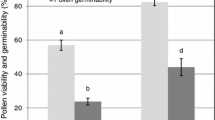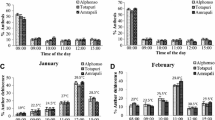Abstract
Field experiments were conducted for 2 years to examine the response of stigma in two different pollination systems, viz., CMS line (MJA5) and open-pollinated variety (Pusa Bold) of Indian mustard (Brassica juncea), to varying weather conditions created by different sowing dates. The CMS line MJA5 (female) with its male line in 8:2 (A:R) row ratio, and Pusa Bold in an isolated field were sown on 21st of October, 30th of October, and 18th of November in 2 consecutive years in North Indian condition. Temporal differences in sowing provided differed weather conditions during flowering, which resulted in variations in the duration to attain the peak flowering stage. Stigma was receptive for longer duration (8 days from the day of anthesis) in CMS line which needs an external pollen source for fertilization to happen, whereas it was only 4 days in open-pollinated variety, assessed in terms of siliqua set and number of seeds/siliqua. Substantial effect of sowing date on stigma receptivity was observed; it was longer in plants sown during October in comparison to those of November in both years. The energy requirement parameters, viz., growing degree days and photo-thermal unit, confirmed that plants sown later failed to accumulate sufficient energy for satisfactory phenological growth and for good seed development.





Similar content being viewed by others
References
Anand IJ (1987) Breeding hybrids in rapeseed and mustard. In: Proc.7th Int. Rapeseed Conf., Poland 79–85
Banga SS, Lavana KS (1983) Heterosis in Indian mustard Brassica juncea (L.) Coss. Z Pflanzenuecht 92:61–70
Byun DH, Park HG (1995) Possibility of contamination during pollination in chinese Cabbage (Brassica campestris spp. Pekinensis). J Korean Soc Hortic Sci 36:21–30
Chakrabarty SK, Yadav SK, Yadav JB (2007) Evaluation of stigma receptivity in cytoplasmic male sterile lines of Brassica juncea (L.) Czern. & Coss. In: Proceedings of the 12th International Rapeseed Congress held at Wuhan, China during March 25–30, 2007. Genetics and Breeding: Heterosis Utilization, ISBN 1-933100-20, 6: 5–7
Chakrabarty SK, Maity A, Yadav JB (2015) Influence of cyto-sterility sources of female line on seed quality of Indian mustard (Brassica juncea L. Czern & Coss.) in relation to storage period. Plant Breed 134(3):333–337
Chakravarty NVK, Galltam RD (2002) Forewarning mustard aphid. Published by Cooperating Centre for Mustard NATP-MMP-17 (Program 6), Division of Agricultural Physics, l.A.R.I., New Delhi. 63
Dafni A, Pacini E, Nepi M (2005) Pollen and Stigma Biology. In: Dafni A, Kevan PG, Husband BC (eds) Practical Pollination Biology, 3, Enviroquest Ltd, Cambridge, Ontario, Canada, pp 111–121
Galen C, Shykoff JA, Plowright RC (1986) Consequence of stigma receptivity schedules for sexual selection in flowering plants. Am Nat 127:462–476
Guerrero-Prieto VM, Vasilakakis MD, Lombard PB (1985) Factors controlling fruit set of ‘Napoleon’ sweet cherry in Western Oregon. Hortic Sci 20:913–914
Gupta R, Sutradhar H, Chakrabarty SK, Ansari MW, Singh Y (2015) Stigmatic receptivity determines the seed set in Indian mustard, rice and wheat crops. Commun Integr Biol 8(5):e1042630. https://doi.org/10.1080/19420889.2015.1042630
Hall AE (1992) Breeding for heat tolerance. Plant Breed Rev 10:129–168
Hedhly A, Hormaza JI, Herrero M (2003) The effect of temperature on stigmatic receptivity in sweet cherry (Prunus avium L.). Plant Cell Environ 26(10):1673–1680
Heslop-Harrison Y (2000) Control gates and micro-ecology: the pollen–stigma interaction in perspective. Ann Bot 85:5–13
Heslop-Harrison Y, Shivanna KR (1977) The receptive surface of the angiosperm stigma. Ann Bot 41:1233–1258
Khadari B, Gibernau M, Anstett MC, Kjellberg F, Hossaert-Mckey M (1995) When fig wait for pollinators: the length of fig receptivity. Am J Bot 82:992–999
Knox RB (1984) Pollen–pistil interactions. In: Linskens HF, Heslop-Harrison J (eds) Cellular interactions, encyclopedia of plant physiology, 1st edn. New Series, Springer-Verlag, Berlin, pp 508–608
Lavana KS, Banga SS (1984) Floral biology in Indian mustard Brassica juncea (L.) Coss. Genet Agrar 38:131–138
Luo RH, Dalvi VA, Li YR, Saxena KB (2009) A study on stigma receptivity of cytoplasmic-nuclear male-sterile lines of pigeonpea, Cajanuscajan (L.) Millsp. J Plant Breed Crop Sci 254–257
Maity A, Chakrabarty SK (2013) Effect of environmental factors on hybrid seed quality of Indian mustard (Brassica juncea). Afr J Agric Res 8(48):6213–6219
Maity A, Chakrabarty SK, Jadav JB (2014) Foraging behavior of honeybees (Apis spp.) (Hymenoptera:Apidae) in hybrid seed production of Indian mustard (Brassica juncea). Indian J Agric Sci 84(11):1389–1394
Maity A, Pramanik P (2013) Climate change and seed quality: an alarming issue in crop husbandry. Curr Sci 105(10):1136–1138
Maity A, Chakrabarty SK, Yadav JB (2012) Standardisation of hybrid seed production technology of first Indian mustard (Brassica juncea) hybrid NRCHB 506. Indian J Agric Sci 82(9):753–758
Maity A, Vijay D, Mukherjee A, Lamichaney A (2016) Potential impacts of climate change on quality seed production: a perspective of hill agriculture. In: Bisht JK, Meena VS, Mishra PK, Pattanayak A (eds) Conservation agriculture: an approach to combat climate change in Indian Himalaya, 1st edn. Springer Science + Business Media, Singapore, pp 459–485
Mankar K S (2000) A technology for the exploitation of hybrid vigour in Indian mustard (Brassica juncea (L.) Czern. & Coss. ) in absence of restorer system. Ph.D. thesis, Post Graduate School, Indian Agricultural Research Institute, New Delhi
Mankar KS, Yadav JB, Singhal NC, Prakash S, Gaur A (2007) Studies on stigma receptivity in Indian mustard. Seed Res 35:148–150
McMaster GS, Wilhelm WW (1997) Growing degree days: one equation, two interpretations. Agric For Meteorol 87:291–300
Morrison MJ, Stewart DW (2002) Heat stress during flowering in summer Brassica. Crop Sci 42:797–803
Neog P, Chakravarty NVK, Srivastava AK, Bhagawati G, Katiyar RK, Singh HB (2005) Thermal time and its relationship with seed yield and oil productivity in Brassica cutivars. Brassica 1&2:63–70
Postweiler K, Stösser R, Anvari SF (1985) The effect of different temperatures on the viability of ovules in cherries. Sci Hortic 25:235–239
Pradhan AK, Sodhi YS, Mukhopadhyaya A, Pental AS (1993) Heterosis breeding in Indian mustard (Brassica juncea (L.) Czern. & Coss): analysis of component characters contributing to heterosis for yield. Euphytica 69:219–229
Prakash S (2001) Utilization of wild germplasm of Brassica allies in developing cytoplasmic male sterility – fertility restoration system in Indian mustard (Brassica juncea). In: Liu H, Fu T (eds) Proc. Int. Symp. Rapeseed Science. Science Press, New York, pp 63–67
Primack RB (1985) Longevity of individual flowers. Annu Rev Ecol Syst 16:15–37
Qiao-yan LI, Jun YIN, Wan-dai L, Mei Z, Lei LI, Jishan N et al (2012) Determination of optimum growing degree days (GDD) range before winter for wheat cultivars with different growth characteristics in North China Plain. J Integr Agric 11:405–415
Rai B (1991) Seed production. In: Chopra VL, Prakash S (eds) Oilseed Brassica in Indian agriculture. HarAnand Publications, Vikas Publishing House Pvt. Ltd., New Delhi, pp 241–256
Rawat DS, Anand IJ (1979) Male sterility in Indian mustard. Indian J Genet Plant Breed 39:412–415
Sanzol J, Herrero M (2001) The effective pollination period in fruit trees. Sci Hortic 90:1–17
Saxena KB, Kumar RV, Latha KM, Dalvi VA (2006) Commercial pigeon pea hybrids are just a few steps away. Indian J Pulses Res 19:7–16
Singh MP, Lallu, Singh NB (2014) Thermal requirement of Indian mustard (Brassica juncea) at different phonological stages under late sown condition. Indian J Plant Physiol 19(3):238–243
Sogo A, Tobe H (2006) Mode of pollen-tube growth in pistils of Myrica rubra (Myricaceae): a comparison with related families. Annals of Botany 97(1):71-77
Srivastava AK, Chakravarty NVK, Sharma PK, Bhagavati G, Prasad RN, Gupta VK, Sutradhar AK, Subba Rao YV, Chopra UK (2005) Relation of growing degree-days with plant growth and yield in mustard varieties grown under a semi-arid environment. J Agric Phys 5(1):23–28
Stephenson AG, Lau TC, Quesada M, Winsor JA (1992) Factors that affect pollen performance. In: Wyatt R (ed) Ecology and evolution of plant reproduction. Chapman & Hall, New York, pp 119–134
Stösser R, Anvari SF (1982) On the senescence of ovules in cherries. Sci Hortic 16:29–38
Warthinhton CM, Hatchinson CM (2005) Accumulated degree days as a model to determine key development stages and evacuate yield and quality of potato in Northeast Florida. Proc State Hortic Soc 118:98–101
Young LW, Wilen RW, Bonham-Smith PC (2004) High temperature stress of Brassica napus during flowering reduces micro- and megagametophyte fertility, induces fruit abortion, and disrupts seed production. J Exp Bot 55:485–495
Acknowledgements
Facilities provided by the Division of Seed Science and Technology and fellowship to the first author provided by the Indian Council of Agricultural Research, New Delhi, during this study are duly acknowledged. The authors are thankful to the Division of Agricultural Physics, Indian Agricultural Research Institute, New Delhi, for providing meteorological data for 2010–2011 and 2011–2012.
Author information
Authors and Affiliations
Corresponding author
Electronic supplementary material
ESM 1
(DOCX 15 kb)
Rights and permissions
About this article
Cite this article
Maity, A., Chakarbarty, S.K., Pramanik, P. et al. Response of stigma receptivity in CMS and male fertile line of Indian mustard (B. juncea) under variable thermal conditions. Int J Biometeorol 63, 143–152 (2019). https://doi.org/10.1007/s00484-018-1645-9
Received:
Revised:
Accepted:
Published:
Issue Date:
DOI: https://doi.org/10.1007/s00484-018-1645-9




